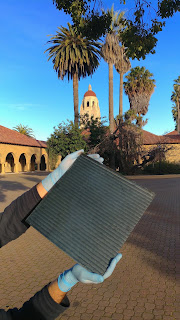Researchers develop ultrafast approach to fabricate perovskite sun oriented modules
Researchers develop ultrafast approach to fabricate perovskite sun oriented modules
Most sun oriented cells today are made with refined silicon that transforms daylight into clean power. Lamentably, the way toward refining silicon is a long way from clean, requiring tremendous measures of energy from carbon-discharging power plants.
For a greener option in contrast to silicon, analysts have zeroed in on flimsy film perovskites—ease, adaptable sun powered cells that can be created with insignificant energy and basically no CO2 discharges.
While perovskite sun oriented cells are promising, critical moves should be tended to before they can get ordinary, not least of which is their inborn insecurity, which makes producing them at scale troublesome.
"Perovskite sunlight based innovation is at an intersection among commercialization and flimflammery," said Stanford University postdoctoral researcher Nick Rolston. "A large number of dollars are being filled new businesses. In any case, I unequivocally accept that in the following three years, if there isn't an advancement that expands cell lifetimes, that cash will begin to evaporate."
That is the reason another perovskite producing measure created at Stanford is so energizing, Rolston said. In another examination, distributed in the Nov. 25 issue of the diary Joule, he and his partners show a ultrafast approach to deliver stable perovskite cells and amass them into sun based modules that could control gadgets, structures and even the power lattice.
"This work gives another achievement to perovskite producing," said study senior creator Reinhold Dauskardt, the Ruth G. what's more, William K. Bowes Professor in the Stanford School of Engineering. "It settle probably the most imposing obstructions to module-scale producing that the network has been managing for quite a long time."
Fingernail-size tests
Perovskite sun oriented cells are slight movies of engineered glasslike produced using modest, plentiful synthetics like iodine, carbon and lead.
Slim film cells are lightweight, bendable and can be filled in outside research centers at temperatures close to the limit of water, a long ways from the 3,000-degree Fahrenheit (1,650-degree Celsius) heaters expected to refine mechanical silicon.
Researchers have created perovskite cells that convert 25 percent of daylight to power, a transformation effectiveness equivalent to silicon. Be that as it may, these test cells are probably not going to be introduced on housetops at any point in the near future.
"Most work done on perovskites includes truly small zones of dynamic, usable sunlight based cell. They're commonly a small amount of the size of your pinky fingernail," said Rolston, who co-lead the investigation with William Scheideler, a previous Stanford postdoctoral researcher now an associate teacher at Dartmouth College.
Endeavors to cause greater cells to have delivered imperfections and pinholes that essentially decline cell proficiency. Also, in contrast to unbending silicon cells, which last 20 to 30 years, slight film perovskite in the long run corrupts when presented to warmth and dampness.
"You can make a little show gadget in the lab," Dauskardt said. "Yet, customary perovskite preparing isn't versatile for quick, proficient assembling."
Record-setting processor
To address the test of enormous scope creation, the Dauskardt group conveyed a licensed innovation they as of late concocted called fast splash plasma handling.
This innovation utilizes an automated gadget with two spouts to rapidly deliver slim movies of perovskite. One spout splash covers a fluid arrangement of perovskite substance antecedents onto a sheet of glass, while different deliveries an eruption of exceptionally responsive ionized gas known as plasma.
"Ordinary handling expects you to heat the perovskite answer for about 30 minutes," Rolston said. "Our development is to utilize a plasma high-fuel source to quickly change over fluid perovskite into a slender film sun oriented cell in a solitary advance."
Utilizing quick shower handling, the Stanford group had the option to deliver 40 feet (12 meters) of perovskite film every moment—around multiple times quicker than it takes to make a silicon cell.
"We accomplished the most noteworthy throughput of any sun oriented innovation," Rolston said. "You can envision huge boards of glass put on rollers and ceaselessly delivering layers of perovskite at speeds never cultivated."
Notwithstanding a record creation rate, the recently printed perovskite cells accomplished a force transformation effectiveness of 18 percent.
"We need to make this cycle as material and comprehensively helpful as could reasonably be expected," Rolston said. "A plasma treatment framework may sound extravagant, however it's something you can purchase industrially for a truly sensible expense."
The Stanford group assessed that their perovskite modules can be made for around 25 pennies for each square foot—far not exactly the $2.50 or so per square foot expected to create a commonplace silicon module.
Sun powered modules
Silicon sun oriented cells are regularly associated together in typified modules to support their capacity yield and withstand brutal climate conditions. Perovskite makers will at last need to construct steady, proficient modules to be financially practical.
Toward this end, the Stanford group effectively made perovskite modules that kept on working at 15.5 percent effectiveness even in the wake of being left on the rack for a very long time.
Traditional silicon modules produce power at an expense of around 5 pennies for every kilowatt-hour. To rival silicon, perovskite modules would need to be exemplified in a weatherproof layer that keeps out dampness for in any event 10 years. The examination group is currently investigating new epitome advancements and alternate approaches to altogether improve solidness.
"In the event that we can construct a perovskite module that keeps going 30 years, we could cut down the expense of power under 2 pennies for every kilowatt-hour," Rolston said. "At that value, we could utilize perovskites for utility-scale energy creation. For instance, a 100-megawatt sun oriented ranch."
Journal information: Joule







0 comments:
Post a Comment
If you have any doubt, Please comment here.